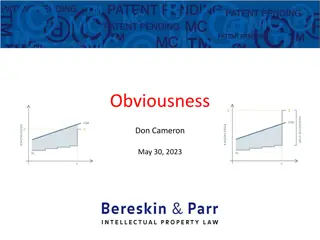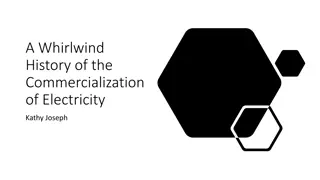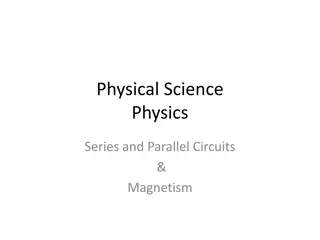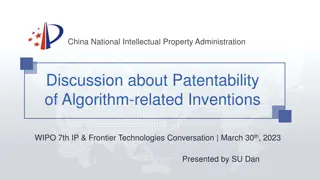Thomas Edison's Other Inventions and Brief Biography
Explore the lesser-known inventions of Thomas A. Edison beyond the phonograph and incandescent lamp. Discover his extensive list of patents and contributions in various fields, including telegraphy, electric railways, wireless technology, and more. Delve into his early period innovations, industrialist inventions, and personal history from childhood to success. Gain insights into the versatile genius of one of history's most prolific inventors.
Download Presentation

Please find below an Image/Link to download the presentation.
The content on the website is provided AS IS for your information and personal use only. It may not be sold, licensed, or shared on other websites without obtaining consent from the author.If you encounter any issues during the download, it is possible that the publisher has removed the file from their server.
You are allowed to download the files provided on this website for personal or commercial use, subject to the condition that they are used lawfully. All files are the property of their respective owners.
The content on the website is provided AS IS for your information and personal use only. It may not be sold, licensed, or shared on other websites without obtaining consent from the author.
E N D
Presentation Transcript
The OTHER inventions of Thomas A. Edison Bob and Kathy Botto Vintage Radio and Phonograph Society Mesquite, Texas November 18th, 2016
The OTHER inventions of Thomas A. Edison We all know about the phonograph and the incandescent lamp What else did Edison invent? Edison had 1093 US Patents, and 2332 patents in the US and worldwide. Edison is known as the man who invented the future many of his inventions are still in use in some form today This talk will describe some of Edison s other inventions with displays and illustrations from the Botto collection.
Edisons Inventions Brief Biography of Thomas A. Edison The Early period (1869-1886) Electric vote recorder (1869) Telegraph inventions (1871-1876) Universal stock printer (1871) Electric pen (1875) Mimeograph (1876) The research laboratory (1876) Carbon telephone transmitter (1877) Magneto-electric machines and lighting apparatus (1878- 1890) Magnetic ore separator (1880) Electric Railway (1880) The Edison Effect (1883) Wireless inventions (1885-1886)
Edisons inventions The Industrialist (1887-1931) Strip kinetograph camera (1889) Kinetoscope (1889) Talking Doll (1890) X-ray fluoroscope (1896) Portland cement process (1898) Ni-Fe alkaline storage battery (1901) Kinetophone (talking picture, 1912) Phenol, benzene and chemicals (1915) Defense related inventions (1916-1918) Natural rubber from goldenrod (1920-1931)
Biography of Thomas A. Edison Born February 11th, 1847 at Milan, Ohio to Sam and Nancy Edison 1854 - Moved to Port Huron, Michigan, home schooled by Nancy 1857 Set up a chemical laboratory in his basement 1859 Newsboy on the Grand Trunk Railroad running from Port Huron to Detroit 1860 Train accident, Edison partially deaf 1862 Printed the Weekly Herald, first newspaper to be typeset and printed on a train 1862 Saved boy from certain death. His father taught him telegraphy 1863 First position as a telegrapher 1863-1868 Tramp telegraph operator experimenting to improve apparatus 1868 Operator at Western Union, Boston, established private telegraph line business 1868 First patent, Electrical Vote Recorder December 1868 With Charles L. Williams, 109 Court St., Boston
Biography of Thomas A. Edison 1869 - Dead broke in NYC. Fixed Gold & Stock Telegraph Company ticker landing him $300/month job, patented Universal Stock Ticker, $40,000 payment 1870 Opened shop in Newark where he made stock tickers and telegraph apparatus, hired John Kreusi and Charles Batchelor 1871 Assisted Sholes in developing the first successful typewriter, married Mary Stilwell, one of his employees 1872-1876 Inventions at the Newark factory, multi-plex telegraph systems, paraffin paper, electric pen etc. 1873 Dot born, Marion Estelle (1873-1965) 1876, Dash, Thomas Edison Jr. (1876-1935) 1876 - Menlo Park, NJ Laboratory built 1878 William Leslie, inventor born (1878-1937) 1876-1886 period of highest productivity at Menlo Park 1884 Death of Mary Stilwell
Biography of Thomas A. Edison 1886 Married Mina Miller (1865-1947) 1888-1898 3 children, Madeline (1888-1979), Charles (1890-1969) Governor of NJ, Theodore Miller, inventor 80 patents 1885-1887 Glenmont, West Orange Laboratory and Ft. Meyers, Florida (neighbor Henry Ford) 1914 - Tragic laboratory fire at West Orange 1915-1924 - Camping trips with Ford, Firestone and Burroughs 1927 - 50thanniversary of the light October 18th, 1931 Edison s death
Edisons First Invention The Electric Vote Recorder was Edison s first invention (pat 6/1/1869) Each legislator moved a switch to either yes or no position, transmitting a signal to a central recorder that listed the names in Yes and No columns The recording clerk placed a sheet of chemically treated paper over the columns of type and moved a metallic roll over it As current passed through the paper the chemicals decomposed, leaving the imprint of the name Dials on either side recorded the number of yays and nays Demonstrated before Congress: If there is any invention on earth we don t want down here, that is it . Never used.
Edisons Telegraph Inventions Edison s love of telegraphy was lifelong. He was proficient at sending and receiving messages as a kid and as a young adult beat the fastest telegraphers 1872 - Quadruplex telegraph duplex was in use to send messages in opposite directions. By combining duplex with diplex Edison sent 4 messages simultaneously enabling Western Union to double messages per wire. Diplex used strong and weak batteries but suffered from signal confusion. Edison used two polarized relays, one to respond to differences in signal strength and one to polarity. Edison invented bug trap to prevent current from falling to zero when polarity changed Quadruplex telegraph was Edison s most important telegraph invention, still in use well into 20thcentury
Electric Pen 1875 The electric pan used a motor to drive a shaft and needle to prepare stencils for duplication. It was a commercial success for several years eventually succumbing to reluctance to use wet cell batteries Edison Automatic Press pat. 1876 covered the pen, duplicating press and accessories
Edison Mimeograph 1876 Office duplicating machine licensed to A. B. Dick Company in 1887
The Research Laboratory 1876 Edison s greatest invention Menlo Park Laboratory was built by Sam Edison in 1876, Thomas added ancillary buildings world s first self contained research laboratory Invention factory during Edison s most creative years (1876-1887) All other research laboratories, GE, Westinghouse, ExxonMobil, Shell etc., have Edison to thank
Carbon Telephone Transmitter 1877 Independently invented by Britain David Hughes, Emile Berliner and Thomas Edison in the US, Edison was ultimately awarded priority Edison s carbon transmitter made Alexander Graham Bell s telephone practical Basis for the microphone, enabled early broadcast radio and telephone repeaters Carbon button transmitters are still in use today! Edison invented the word hello
Coal Particle Telephone (early 1880s) Purchased at HVRA auction for $5 Uses Transmitter as a Receiver and includes lightening arrestor
Electrical distribution systems (1878-1890) Long Waisted Mary Ann dynamo (1879) was 90% efficient
Edison Jumbo DC dynamo (1881) 27 tons, 100kW
Chemical Meter (1882) Edison invented a chemical meter based on electrolysis of copper to bill his first customers Meter not ready for Pearl Street in 1882 so customers got electricity free
Pearl Street Station (1882) Went on line in lower Manhattan at 3pm September 4th1882 with 6 Jumbo dynamos supplying 400 lamps
Edison Illuminating Company Bulletin (1882) From the safe of Samuel Insull, Edison s personal secretary and founder of Edison General Electric, later VP of General Electric
Magnetic Ore Separator (1880) His idea was to use magnetism to upgrade low quality iron ore Acquired rights to 145 abandoned mines and set up a pilot plant at Ogden, N.J. Engineering problems never worked out and project nearly sunk him (1880-1890 s)
Electric Railway (1880) Siemens first exhibited a 0.3 mile electric railroad in 1879 Edison s was also 0.3 miles and equipped with a light 12 horsepower dynamo employees were treated to rides at 40 mph In 1882 track was expanded to 3 miles, and thousands of visitors rode (with some minor accidents)
The Edison Effect (1883) Edison noticed his lamps blackened by deposits, theorized molecular bombardment Pt foil placed between filaments yielded a current when placed in a circuit Patented the effect but could never explain it (electrons not discovered until J.J. Thompson in 1897) Basis for Fleming Valve rectifier and Deforest Audion
Did Edison invent Wireless? (1885-1886) Edison employed induction to send telegraph signals from railroad cars through the air to telegraph line along tracks and to a remote receiver Grasshopper Telegraph was a technical success but lacked commercial interest During Blizzard of 1888 trains buried in snow sent messages by grasshopper telegraph this was the first case of wireless used for rescue
Induction Wireless for Long Distance Messaging (1885) Years before Marconi, Edison patented his means for transmitting signals electrically (US Pat 465971, submitted May 1885, patented 1891) Used elevated induction plates (or balloons) and an earth or ship ground at both transmitting and receiving ends to overcome the curvature of the earth and to reduce to minimum the earth s absorption The primary circuit of the induction coil includes a battery and a device for transmitting signals which may be a revolving circuit breaker operated continually by a motor and a key short circuiting the circuit breaker or secondary coil The key normally short circuiting the revolving circuit breaker, no impulses are in the induction coil until the key is depressed For receiving signals I locate in said circuit between the condensing surface and the ground a diaphagm sounder, which is preferably one of my electro-motograph telephone receivers Electrostatic impulses are transmitted inductively to the elevated condensing surface at the distant point. The intervening body of air forms the dielectric of the condenser
Means for Transmitting Electric Signals (1885) Edison (1885) Hertz (1886) Marconi (1896)
The Strip Kinetograph Camera and Kinetoscope (1889) Project headed up by William K.L. Dickson Edison: I am experimenting with an instrument which does for the eye what the phonograph does for the ear. The Strip Kinetograph used 35 mm strip film from George Eastman The Kinetoscope was a peep show viewer to play the 20 second reel The first Kinetoscope parlor was opened in 1894 in NYC Edison bought the rights to Thomas Armat s movie projector in 1896 it enabled movies to be projected on to a screen with subtitles added Edison patented the kinetophone for talkies in 1912
Edison Talking Doll (1890) Edison talking doll recordings are among the oldest extant
X-ray Fluoroscope (1896) Edison invented the x-ray fluoroscope in 1896 shortly after x- rays were discovered by William Roengten in 1895 His technician Clarence Dalley experimented with and exhibited the fluoroscope, eventually dying from the effects of radiation Edison walked away: Don t talk to me about x-rays. I m afraid of them.
Portland Cement Process (1898) Edison used his knowledge of ore processing to improve the Portland cement process Edison s new kilns were the largest in the world (150 feet) Eventually he saturated the market and went bankrupt Edison built pre-fab concrete houses, Yankee Stadium in 1922 and even concrete phonograph cabinets
Edison Portland Cement Company Stock (1899) This certificate for 500 shares was actually owned by Edison
Ni-Fe Alkaline Storage Battery (1901) Waldemar Junger (Swede) invented Ni-Cd battery and experimented with Ni-Fe in 1899 but technology was little known in the US Edison developed the Ni-Fe alkaline battery to replace the lead-acid battery for starting gasoline engines and for electric cars Unfortunately Detroit continued to use lead-acid for starting and electric cars went out of vogue in early part of 20th century Edison Ni-Fe batteries were profitably made from 1903-1972 by the Edison Storage Battery Company and by Exide from 1972-1975
Edisons instructions on battery experiments Handwritten instructions by Edison on chemicals for his battery experiments signed Edison
Edisons phenol plant and the phenol plot (1915-1917) Edison needed phenol capacity for making Edison Diamond Disc records and a manufacturing plant was built near Johnstown, Pa making 12 tons per day Phenol was also used to make aspirin and explosives American Bayer (German company) needed the phenol to make aspirin. US was leaning toward Britain so explosives were needed for the war effort Bayer s agent Heinrich Albert plotted to divert the phenol from explosives to aspirin by setting up a front company to buy Edison s overproduction (funded by Germany) Contents of Albert s briefcase, left on a train, were found and leaked to the press Edison, embarrassed, sold the rest of his phenol to the US military
Edisons Defense Related Inventions (1916- 1918) Edison threw his inventive genius behind the war effort in 1916-1918 Edison said that the Navy needed a research laboratory and Edison was made President of a Naval Consulting Board The Naval Laboratory was established at Annapolis (not Edison s preference) Edison s efforts focused on submarine detection under water by end of 1917 they could be detected at 5,000 yards Edison made about 45 war related inventions including nets for catching torpedoes and a gas mask for sailors exposed to sulfur gases on ships masts
A Substitute for Natural Rubber (1920- 1931) Edison realized in the 20 s that another war was coming and that when it did, the first thing Germany would do was to cut off America s access to natural rubber At the request of Henry Ford and Harvey Firestone Edison was asked to find a substitute for the rubber in automobile tires Edison tested thousands of plants before finding a type of giant goldenrod that could be used to make rubber Edison was working on this at the time of his death and the West Orange, N.J. National Historic Site maintains his final experiments intact including his lab coat hung by his bench























